#world champion 750 & 500cc
Explore tagged Tumblr posts
Note
always am obsessed with motorsport champions that decide to run the number 1 plate vs those who’ve stuck with their number. because it reveals so much of each of their inner philosophies, whether they are deeply superstitious, or seek a tangible everyday proof of their victory, or concerned with branding/legacies, or trampling the inner critic that believed deep inside of them that they were cut out to be a champion. just so interesting to parse through possible motivations
you're so right anon!!
of course, a big part of it is historical context... you can't really disentangle the choice of whether to run the number one plate or not from the era within which they made said choice. until fairly recently, it was entirely the norm to pick the number one plate - and beyond that, even those who didn't finish in first tended to just adopt the number that represented the place they had finished in during the previous year's championship. so for instance in 1987, gardner was first, mamola second, lawson third, haslam fourth, macckenzie fifth, and so on. in 1988, gardner ran the number 1 plate... mamola 2, lawson 3, haslam 4, mackenzie 5, etc etc. the only champion who broke with tradition was british racer barry sheene (500cc champion in 1976 and 1977), known for being a rebel - and even the styling of his iconic number 7 was apparently a wee bit controversial:
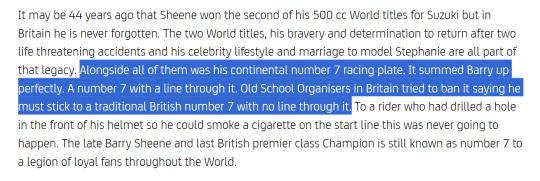
sheene stuck with the 7 both after his formula 750 title and then after his two 500cc titles:


there's some ways in which sheene is kinda the prototype of the modern rider, and he was the first to reap the benefits of having a distinctive number associated with him
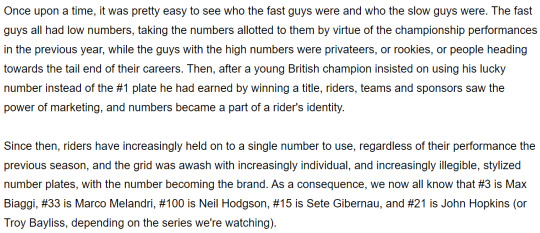
in the eighties and nineties, it was all back to number one plates - but then of course another rider decided to break with tradition
incidentally, the generally purported story for why valentino took the number 46 is that it was his father's number. if his autobiography is to be believed, the truth is a little different:
I am Valentino. Graziano chose that name for me because he wanted to honour the memory of his best friend, who drowned at sea, near Pesaro, at the age of eighteen. The fact that St Valentine's Day is just two days before my birthday was also a reason. Number 46 originated when I raced minibikes. I was on a team with two kids from Gatteo a Mare, Marco and Maurizio Pagano. They are the brothers who lent me the Aprilia 125, which I used for my debut at Misano. All three of us had number 46 because we raced in three different categories. They too loved Japan and Japanese riders. One day we were mesmerised by a wild-card entrant at the Japanese Grand Prix who pulled off the most amazing tricks and seemed to have no fear whatsoever. He was number 46. And from that day on, so were we. For me, that lasted until I moved up to the Italian championship and, later, the European series. But when I finally made it to the world championship, I was asked to choose a number. I discovered that 46 was Graziano’s number when he won his first Grand Prix on a Morbidelli 250cc, back in 1979. Which was the year I was born. That’s why I decided that I, too, would be number 46. For me that number represents my career and, partly, my life. It certainly symbolises my massive, incredible, adventure.
so valentino was only the second premier class rider who stuck with his number. the norm of just following the previous year's standings to choose your number was kinda starting to die out in the late nineties anyway. by 2002, when valentino was defending his title for the first time, if you look down the list it's basically personal numbers all the way. still, valentino was the one to break tradition for champions - the first to do so in a couple of decades. valentino did also know sheene personally as a result of the link through his father, who was a friend of sheene's and had raced him:
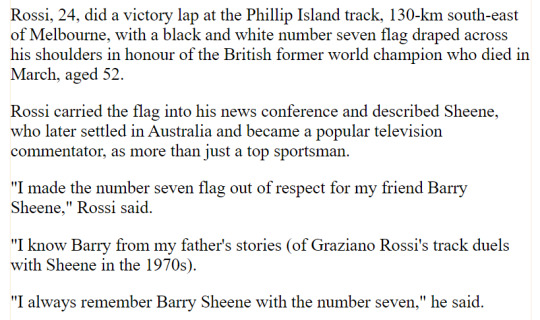
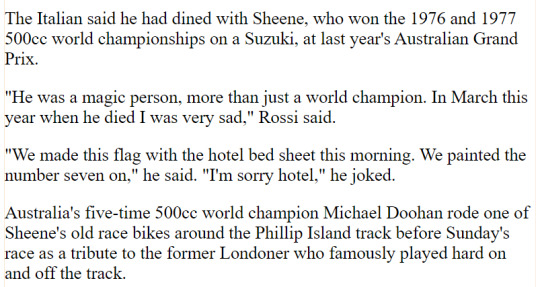


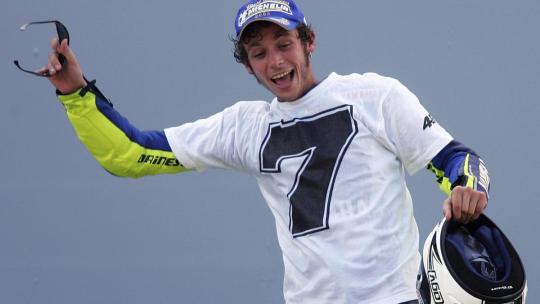
^valentino with sheene, valentino wearing a tribute helmet with the iconic '7' on it after sheene's passing (also with the rainbow helmet colours and the word 'pace' or 'peace' on the back during the 2003 invasion of iraq), and valentino's 2005 championship celebrations for his seventh title, his shirt again featuring sheene's seven
hayden didn't follow valentino's example and instead went for the number one plate in 2007. casey made the same choice for the 2008 season, then jorge in 2011... so for a hot moment it really did look like valentino had been just another blip. if anything, the trend was going the other way, with a couple of high profile instances of riders who hadn't won the title rejecting their established numbers:
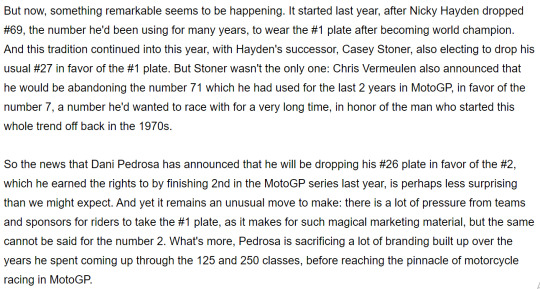
this particular trend didn't catch on, and from 2010 onward dani decided to just stick with the 26. because all the non-valentino aliens just couldn't stop faffing about with their numbers, 2010 is the only year in which all four aliens are actually concurrently running the numbers we most commonly associate them with

then, by 2012 apparently people were starting to get a bit superstitious about the number one plate. here, from an interview with casey:

the idea is that you can't defend the title if you're sporting the number one plate. which is true! in the 21st century, three guys chose the number one plate, and they defended their titles a grand total of zero times. one bloke stuck to his number, and he defended his title five out of seven times. so yes, it is technically correct that nobody with the number one plate had defended their title, though it is equally true that nobody not called valentino rossi had defended their title. I suppose we'll never know what the bigger factor was
anyways, if picking the number one plate was already a sure thing before, I reckon this sort of silly talk about 'jinxes' would have made casey even less likely to change his mind for 2012. not only is he stubborn, but he also takes an extremely dim view on superstitions
That race was the twelfth in a row that had been won by a rider not starting from pole, which was a new record. People were making a big deal about it and questioning whether, psychologically speaking, it wasn't a good thing to qualify on pole position at all. Maybe to the superstitious riders out there it had become an issue but I have never allowed myself to be affected by outside influences like that and I put an end to the stat by winning from pole in the next round at Laguna Seca in California. It is amazing how many riders have superstitions, which to me are completely ridiculous. Pretty much every one of them has a little mascot or a lucky pair of undies that they once had a good result in and have been stuck with ever since (so to speak!). Superstition is basically just fear and as an athlete my view is that by allowing it to enter your mind you are effectively handing over control. My approach has always been to deliberately tackle it by doing things differently to the last time, just to make sure I don't get into a restrictive habit. Some riders look at their qualifying position and think, I never go well from fifth position, or arrive at a circuit thinking about past results there and say, 'I've never done well here before, it's not my favourite circuit.' You have to be in the mindset that every day is a new day, a new set of circumstances. Every corner is different, every situation is different, and if you are not prepared to open your mind to that then you will always struggle more than necessary. You might have been through one particular corner a thousand times before but with a slight change in temperature, a new bike, a different tyre or a rider trying to pass you on the inside it becomes a completely different challenge and you have to be ready to deal with that.
given that casey is like, neurotically anti-superstition - well, he was probably always going to do the same thing as he did in 2008, but now he definitely would never just stick with his number. unlike jorge... who did change his mind, having run the number one plate in 2011 - but decided against making the switch in 2013. funnily enough, this did not help him defend the title. the eventual 2013 champion ended up also opting to stick with his number... and, well, marc's title defence went a little bit more smoothly. after jorge's 2015 title, he once again stuck to his 99, while marc has used the number 93 throughout his career. by the time you get to 2020, it's easy to have a warped perception of how common it is to keep your number. if you're born in, say, 1997 or later, you think it's basically the done thing to stick to your number, and it's really only a few outliers who use the number one plate. but even in the 21st century... it's really just valentino and marc who were doing it, plus jorge two out of three times. but between the two of them, they sure were winning enough of the titles to make it feel like the established norm
by this point, there really was a bit of a superstition about how the number one plate was 'cursed'. obviously, this wasn't actually a 'curse' as much as it was 'the dominant force in the sport in the noughties decided this number one plate thing wasn't for him and the dominant force in the 2010s who also happens to a massive fan of the other guy also decided not to make the switch either so that probably explains it'. it's not 'you won't defend your title if you're sporting the number one plate', it's 'you won't defend your title if your name isn't valentino rossi or marc marquez'. but obviously, sports drives people insane, so it was always going to be something that prompted a lot of speculation until someone finally managed to defend the plate
following his 2020 championship, mir didn't depart from the new tradition, with a suzuki video to announce his decision:

and fabio did likewise after his 2021 title:
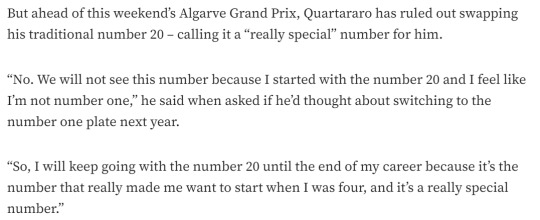
obviously, sticking to their numbers didn't actually help joan and fabio defend their titles, and after his 2022 championship it was pecco's turn to make the choice. pecco went about this in the most pecco way imaginable, with just a touch of public hand-wringing about the whole thing:


just as a quick reminder, before pecco there had been 28 premier class champions. five and two thirds decided against the number one plate - sheene, valentino, marc, joan, fabio, and jorge twice. "I have always been fascinated about riders with number one" describes something that until very recently had been completely normal. not even remotely noteworthy. cheers valentino
eventually, presumably after some extremely extensive introspection, pecco decided to go for the number one plate:


and also this:

and also this (look he's got a lot of thoughts on the matter, please allow him):

and talking about defending the number one:

pecco has continued talking about it sporadically since then. he's spoken about it in the context of defending his title, which as he points out he can only remember marc and valentino doing:

and then the pressure inherent to sporting that plate, from after he'd successfully completed his title defence:
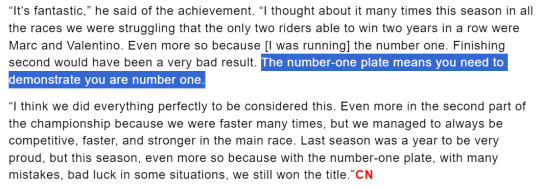
hm. right. let's unpack
the thing about this whole 'running the number one plate' business is that in motogp, each rider's individual choice has to be read with that history in mind. for many years, this wasn't even really a question... it's just what you do when you win the title. sheene was the rebel, the one who decided to do things differently, who wanted to be associated with his very own number. and valentino, who himself knew sheene and was already attached to his own number and has always had a good sense for personal branding, decided to stick with 46. of course, valentino being valentino, he's inescapable enough within motogp that ever since he made that choice, every single champion after him has had to actively make a decision one way or another
so you've got jorge, who had used the number one plate in his title defence during his 250cc campaign in 2007 - and also used it in 2011 as motogp defending champion. he ended up changing his mind for his following two campaigns... remember, he only started using the number 99 in 2009 after his fractious split with his manager during 2008 (see more on numbers lore here). here was what he said about his decision in 2011:
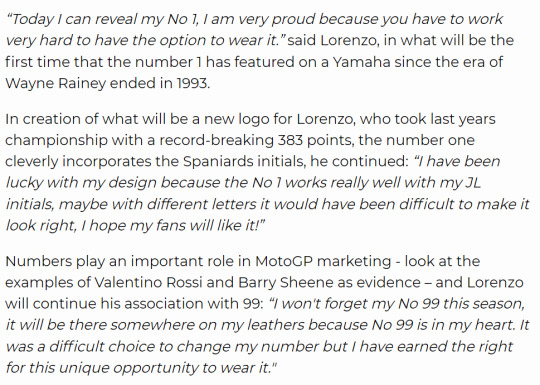
versus his decision in 2015:

jorge in particular does of course have a bit of a complicated relationship with the numbers he's used during his career - and unsurprisingly he's clearly put quite a lot of thought into the whole matter. he's determined to still have the number 99 represent him in some way even in 2011, while also thinking about how he can integrate the number one into his initials - and since it's jorge, of course it's particularly important that his fans approve. he "won't forget" his 99, it was still on his leathers because it's still 'in his heart'... but he explains it by saying he has "earned the right", that it's a "unique opportunity". then, a few years later, his main cited reason for sticking with the number 99 is how it 'represents' him
very much a question of identity, then, something about how jorge made the choice to use the 99 and how it was an expression of liberation for him... he was tempted by the number one once and only once - a statement in itself, following on from jorge's title win in 2010 where the oppressively popular defending champion had been taken out of contention through injury. jorge says he's 'earned the right' because he feels like he deserves it and he wants to tell the world as much. did his failure to defend the title play into his decision not to run the plate again or did he just decide it wasn't really for him after all? did he realise he had grown so attached to the number 99, what it symbolised to him, that he didn't want to give it up again? or did he just realise it was better for personal branding?
last year, here's what casey had to say:

it's fun how the perception of it has changed so drastically, hasn't it? now it's kinda the brave decision to take it... and that's mainly the legacy of two blokes who happened to monopolise this century of racing and decided to make their numbers their own (you may have noticed that there's considerably less material out there on why they made the choice they did). it's gone from something that you just sort of did automatically to something that puts a bit of a target on your back. because that's the subtext, right - everyone wants to 'take the number one plate'... which obviously they do anyway, but all this talk of curses and jinxes attempts to give it a bit of extra weight. is it presumptuous to take that number? valentino and marc made the call to stick to their numbers - and years later it's become a statement to deviate from that path. in that fabio quote above, in context he's really just trying to say he feels like he's the number 20 and nothing other than that - but "I feel like I'm not number one" is still a teensy bit loaded. how did marc's injury affect the choice made by those in his absence?
casey is unsurprisingly very firm on the whole thing, "you are world champion and you should be wearing number one". as if doing anything else is shying away from this duty. defending the title is another "challenge" that he says he likes - almost like a way of putting extra pressure on himself. though in a different interview, casey also says this:

just a number after all, then? it's also interesting how they frame it in different ways, isn't it? for casey it's "recognition" of an achievement, for jorge it's something you've "earned"... and for pecco, it's something you "need to respect". it's about something that puts "pressure" on you... perhaps that's partly because so much of the discourse about the number one plate has become about defending the title (or failing to do so), but pecco discusses it more as a responsibility than something he deserves. you can tell that it's clearly preoccupied him for a while - it's something he's "fascinated" by, he's "admired" people who have done it, he's "always loved it". for both casey and pecco, part of it seems to be about respecting the history of all the blokes who have used the number in the past, like it's an act that pays tribute to that heritage. you'd think this shouldn't have been such a tough choice in the first place, wouldn't you? goes to show how much of a break with tradition it's become - tradition, of course, that was really started by pecco's own mentor. would it be that surprising if that's part of the reason for the reticence? and, at the same time, would it be that surprising that his mentor's long shadow might make him feel like he needs that big and bold number one? what does pecco think it's saying that he went a different way? all this public hand-wringing just because he's breaking a trend
for jorge, the number one plate was a public declaration that he'd made it, naysayers be damned. to pecco, "the number one plate means you need to demonstrate you are number one". it's like giving yourself a point to prove... is it mainly a matter of pride or giving yourself something to live up to? both of them go to great pains to stress their continued attachment to their original number, how they're continuing to integrate it into all their cute designs... and that is something that has changed pretty definitively - not entirely as a result of valentino, but around the same time as valentino emerged as the figurehead of the sport, and he's certainly a big part of it. even the riders who go with the number one still want to have their number and to be known by it. the numbers have become such an integral part of branding and rider identity that riders want to make clear how important they are to them, whether they stick with the number as defending champions or not
at the same time, the fact that taking the number one plate has been de-normalised means that this decision places extra focus on the challenge of defending the title. pecco might not frame his choice in opposition to valentino and marc's to keep their numbers, but he does repeatedly link it to how they alone had been able to win successive titles. for him, then, it becomes an indirect way of living up to a legacy - counterintuitively by doing the opposite of what they did. "since I remember, was just marc and vale have repeated the title" “I thought about it many times this season in all the races we were struggling that the only two riders able to win two years in a row were marc and valentino"... that's what he's trying to live up to, this simultaneous source of inspiration and insecurity. are you lacking confidence if you need to see the number one to believe yourself that you are the number one? or is it conversely shying away from something you have rightfully earned if you can't bring yourself to take the plate? is it an expression of ego if you think your personal number is more meaningful than the number one could ever be? personal branding decisions aside, wouldn't manufacturers much rather you display the number one plate proudly on their bikes?
kind of remarkable, isn't it? it should be such a simple choice... and yet. not only is it now a question of branding and identity, but within motogp it's also become one of how you relate to the legacy of two specific riders. maybe it'll gradually become more common again to take the plate - after all, the curse has now been broken. or maybe it will be the source of much hand-wringing forevermore... we shall see. we shall see
#personally I'd always keep my own number lol. but I also think pecco specifically made a good call#though maybe it would've helped to do a little bit less public introspection and hand wringing and soul searching#poor little ferret wants a number one on his bike. needs to write essays justifying it. buddy it's fine who cares#batsplat responds#//#brr brr#does it bother anyone else that valentino doesn't actually use a continental number seven? no? just me?#some of sheene's 7s didn't have the dash. which. there may be a good reason for this but it doesn't quite feel like ideal branding-wise#taking a massive sharpie to valentino's title winning shirt#incidentally schwantz generally stuck to his 34 until he won the title. thought it interrupted the flow too much to mention it but#current tag#alien tag
55 notes
·
View notes
Text

Barry Sheene - Motor Cycle Racing Ltd (Legannd)
#barry sheene#7#suzuki#world champion 750 & 500cc#barry sheene was a god#barry sheene is a god#barry-sheene#texaco#heron#yamaha#formula 750 world champion 1973#killer velo#killer veloccphotoblog#killer velo custom cycles#nn-art
84 notes
·
View notes
Photo

Thank you for accepting me, I send you a photo of my dear Victor Palomo, World Champion F 750 1976. Anderstorp 500cc 1974, followed by Tom Herron.
30 notes
·
View notes
Text
About Barry
Barry Sheene, Motorcycling's first superstar
Earlier Life
Born in London, Barry was the second child of parents Frank (resident engineer at the Royal College of Surgeons, himself a former competitive rider who retired in 1956 and an experienced motorcycle mechanic) and Iris. He grew up in Queen Square, Holborn, London. Before entering road racing Sheene found work as a messenger and delivery driver.
Racing Career
Barry first started to race in 1968, winning his first races at Brands Hatch riding father Frank's 125 cc and 250 cc Bultacos. He became the British 125cc champion at age 20 in 1970. In 1971 riding an ex-works 1966 10-speed Suzuki twin, previously ridden by Stuart Graham he finished second in the 125 cc World Championship. His first Grand Prix win coming on that bike at Spa in Belgium, soon followed by a win on a 50 cc Van Veen Kreidler at Brno in Czechoslovakia, where he finished over two and a half minutes ahead.
For 1972 Barry was signed to the works Yamaha team for the 250 cc World Championship. However, at the third round in Austria, after losing a sprint to the finish line to the Australian John Dodds for third place, he voiced his displeasure to team management about the performance of the bike and was dropped from the team with immediate effect. His works Yamaha YZ635 was then given to the Finnish rider, Jarno Saarinen who went on to use the bike to win the World Championship that year.
Barry was signed by Suzuki during the off season 1972–1973 and won the newly formed Formula 750 European championship for them in 1973. As a works Suzuki rider Sheene had two contracts, with the World Championship events taking precedence over his Suzuki GB contract for home and International events, if any race dates clashed.
For 1974 Suzuki introduced the RG500 which Sheene rode to a second, third and a fourth scoring 30 points and finishing sixth in the World Championship.
A spectacular crash at the Daytona 200 in the 1975 season threatened to end his career, breaking his left thigh, right arm, collarbone and two ribs, yet he recovered and was racing again seven weeks afterwards. Again riding the RG500 he scored a memorable first 500 cc win at the Dutch TT.
In the 1976 season, he won five 500cc Grands Prix, bringing him the World Championship. He took the Championship again in the 1977 season with six victories. For the 1977 season Sheene was partnered by Steve Parrish, who rode Barry's 1976 Suzuki 500 cc machine.
Barry's battle with Roberts at the 1979 British Grand Prix at Silverstone has been cited as one of the greatest motorcycle Grand Prix races of the 1970s. After the 1979 season, he left the Heron-Suzuki factory team, believing that he was receiving inferior equipment to his team-mates. He switched to a privateer on a Yamaha machine, but soon started receiving works equipment. In 1981, Kenny Roberts the reigning World 500cc Champion for the third time in succession. Sheene, by now on a competitive Yamaha, was determined to take the championship from him. Ironically, Sheene and Roberts battled all season and let Suzuki riders Marco Lucchinelli of Italy and American Randy Mamola beat them for the top two spots. Roberts finished third and Sheene fourth in the final World Championship standings.
A crash at Silverstone where Sheene, riding his Yamaha, hit the obscured fallen machine of Frenchman Patrick Igoa during practice for the 1982 British Grand Prix largely ended his potential as a title threat, and he retired in 1984. He remains the only rider to win Grand Prix races in the 50cc and 500cc categories.
Barry was known for being outspoken in his criticism for what he considered to be dangerous race tracks, most notably, the Isle of Man TT course, which he considered too dangerous for world championship competition. He was a colourful, exuberant character who used his good looks, grin and London accent to good effect in self-promotion, and combined with an interest in business was one of the first riders to make a lot of money from endorsements. He is credited with boosting the appeal of motorcycle racing into the realm of the mass marketing media. He also tried his hand as a TV show host, including the ITV series Just Amazing!, where he interviewed people who had, through accident or design, achieved feats of daring and survival (including the former RAF air gunner, Nicholas Alkemade, who survived a fall of 18,000 feet without a parachute from a blazing Avro Lancaster bomber over Germany in March 1944). Sheene and his wife Stephanie also starred in the low-budget film Space Riders.
Personal Life
In 1975 while on crutches, Barry met model Stephanie McLean, the couple married in 1984, having a son Freddie and daughter Sidonie.
Emigration to Australia
The Sheene family moved to Australia in the late 1980s, in the hope that the warmer climate would help relieve some of the pain of Barry's injury-induced arthritis, settling in a property near the Gold Coast. He combined a property development business with a role as a commentator on motor sport. He began on SBS TV then moved to the Nine Network with Darrell Eastlake, and finally followed the TV broadcast rights of the Grand Prix motorcycle series to Network Ten. Further to this, on Network Ten Barry co-hosted the weekly motor sport television show RPM from 1997 to 2002 with journalist Bill Woods, and was involved in Ten's coverage of other motor sport including V8 Supercars for several years.
In the 1990s, Barry appeared in a series of well known and popular television advertisements for Shell, with Australian motor sport icon Dick Johnson. In later years, Barry became involved in historic motorcycle racing, often returning to England to race at Donington Park. He was also chosen to run with the Queen's Baton in the run-up to the 2002 Commonwealth Games held in Manchester, England.
Death
In July 2002, at the age of 52, Barry was diagnosed with cancer of the oesophagus and stomach. Refusing conventional treatments involving chemotherapy, Barry instead opted for a holistic approach involving a strict diet devised by Austrian healer Rudolf Breuss, intended to starve the cancer of nourishment. He died peacefully surrounded by his family at a hospital on Queensland's Gold Coast in 2003, aged 52, having suffered from the condition for eight months.
Honours and Awards
Following reconstruction of the Brands Hatch Circuit in England for safety concerns after requests by the F.I.M., the Dingle Dell section was changed for safety, and shortly after Barry's death the new section was renamed Sheene's Corner in his honour. The FIM named him a Grand Prix "Legend" in 2001. For the 2003 season, V8 Supercars introduced a medal in honour of Barry, the Barry Sheene Medal, for the 'best and fairest' driver of the season. A memorial ride from Bairnsdale, Victoria to Phillip Island is held by Australian motorcyclists annually, before the MotoGP held at the island.
In Popular Culture
On a side note, the obscure Eric Idle song "Mr. Sheene" which describes "Mr. Sheene's riding machine" appears to be about Barry Sheene. It was released as a B-side of the 1978 single "Ging Gang Goolie" and is credited as released by Rutles-offshoot duo "Dirk and Stig." He is also featured on one of Artist Grayson Perry's Vases My Heroes (1994). Barry also featured in a number of Brut adverts alongside boxer Henry Cooper.
Image © Gerard Kampen. All Rights Reserved © Estate of Barry Sheene. Managed by Santara Group
HOME
ABOUT BARRY
GALLERY
ART
BOOK
THE ESTATE
CONTACT US
This site uses cookies to personalize your experience, analyze site usage, and offer tailored promotions. www.youronlinechoices.eu Remind me later I accept
3 notes
·
View notes
Text
The Ninth Annual Quail Motorcycle Gathering


The Quail Motorcycle Gathering on May 6 included more than 350 drool-worthy vintage and custom motorcycles, from Italian tiddlers to full-on race bikes, arrayed on the green grasses of the Quail Lodge & Golf Club in Carmel, California. All this eye candy was fawned over by around 3,000 people – record attendance for the nine-year-old event. It was enough to warm the heart of any gearhead. This year’s Quail centered around one of the most influential bikes in history: the Norton Commando of the late ’60s and early ’70s. Almost every model and color was there, causing a near state of weepiness on the part of riders of a certain generation.

Norton unveiled the Commando at the lavish ’67 Earls Court Show in London. It was an immediate hit thanks to its “Isolastic” frame system that softened the paint-shaker tendencies characteristic of old parallel-Twins. Over the next decade more than 50,000 were sold. And for many, the Norton Girls ad campaign was even more memorable than the bikes, with scantily clad models draped across the bikes. The event also honored two-time AMA Grand National Champion and three-time World 500cc Grand Prix Champion Kenny Roberts as this year’s Legend of the Sport. “Getting Kenny here was a personal coup,” says event director Gordon McCall, who also runs the Motorworks Revival and is a class judge at the Pebble Beach Concours. “He doesn’t really go for the grand master thing, so it’s cool that he accepted. The Quail weekend began with the Quail Ride on Friday, including a stop at a local winery and a visit to the nearby Moto Talbott vintage motorcycle museum. Sneak Peek: Robb Talbott’s Moto Museum Saturday included a ride around the surrounding area as well as the lovely display of amazing motorcycles at the Quail Lodge. Some may carp about the $95 cost of entry for the show, but it does include a lot: a full lunch, live music, kids area, and parking. By the end of the day, you actually feel like you get a fair amount for your money.

Will this event – now considered one of the premier vintage shows in the country – continue to grow? Maybe not, but that’s by design. McCall says he’s happy with the size of the Quail just as it is. (The number of bikes on display actually went down, from 400 to 350.) “We don’t need more bikes,” he says. “I want people to feel like they’re able to see everything.” We tried. And we had fun doing it. Here are the category winners. Best of Show, First Place Competition On-Road 1957 Mondial 250 Grand Prix Double Overhead Cam John Goldman – California

Antiques 1918 BSA Model H Bud Schwab – California

American 1937 Indian Chief Kalle Hoffman – California

British 1939 Brough Superior SS100 William E. “Chip” Connor – Hong Kong

Italian 1959 Moto Parilla 99 Olimpia Vincent Schardt – California

Japanese 1976 Yamaha XT500C Owen Bishop – California

Other European 1976 Hercules W2000 Wankel Stephan Haddad – California

Competition Off Road 1975 Husqvarna 360 Flat Tracker Clyde Williams – California

Custom/Modified 1958 Triumph Tiger Bryan Thompson – California

Extraordinary Bicycles/Scooter 1971 NYPD Lambretta LI150 Special Siobhan Ellis – California

AMA Motorcycle Hall of Fame Heritage Award 1983 Honda Factory RS 750 Flat Tracker Anthony Giammanco – California

Significance in Racing Award 1995 Britten V1000 #10 Virgil Elings – California

The Cycle World Tour Award 1980 Suzuki GS1000S Trevor Franklin – British Columbia

Historic Vehicle Association Preservation Award 1942 Indian Pre-War Big Base Scout Gary Landeen – South Dakota

Design and Style Award 1975 Moto Guzzi 850T Untitled Motorcycles – California

Innovation Award 1991 BMW Alpha Mark Atkinson – Utah

Industry Award 2015 Prototype Fuller Moto Motus Naked John Bennet – California

Fuller Custom Motus Dyno Run 50th Anniversary of the Norton Commando 1968 Norton Fastback Jeff McCoy – California

Spirit of The Quail Award 1948 Triumph T100 Tiger Jonnie Green – California


Morning prep; placing a Moto Guzzi custom into its proper place.

Polishing a beautiful Vincent.

Where should I put my Honda CBX custom?

Quail founder Gordon McCall with Indy 500 winner Danny Sullivan.

Many of the featured Nortons were highly polished gems.

A well-worn Norton Commando.

The infamous Yamaha TZ750 flat tracker ridden by Legend of the Sport Kenny Roberts, with original owner, Ray Abrams of A&A Racing.

Mert Lawwill, Grand National Champion and star of the film, “On Any Sunday,” builds prosthetic limbs designed for motorcycling.

The monstrous powerplant of the Yamaha TZ750 flat tracker, which prompted King Kenny Roberts to say, “They don’t pay me enough to ride this thing,” after winning the Indy Mile.

A pair of the original Honda Africa Twins, designed to win the grueling Dakar endurance race.

A Yamaha XS650-based flat tracker, complete with psychedelic 1970s paintwork.

Replica of multi-time Grand National Champion Ricky Graham’s Honda RS750.

Fire up your race bike and draw an instant crowd.

Innovation Award winner: somewhere in this exotic machine is a BMW K75 powertrain.

Robb Talbott, founder of the world famous MotoTalbott museum in nearby Carmel Valley, on his MV Agusta 750S.

A covey of Quail judges scrutinizing an Indian Chief.

1936 Vincent HRD Comet.

The bike that Kenny built. The Proton was Roberts’ foray into being a MotoGP team owner and bike builder. This one was set up for his son Kurtis.

We have seen the future of motorcycle lighting, and it is LEDs.

Twin twins: a BSA dual-engine drag bike.

Classic BMWs always attract a strong following.

Macro photography of a Honda Benly badge.

Indian in blue.

Always cool… scrambler pipes.

Cooler still… Ariel fishtails.

Vintage drivetrain with exposed everything.

Beauties and a beast.

Kawasaki H2 750 triple, running a tad rich on two-stroke oil. No more worries about mosquitoes in the area.

This exquisite example of a CZ twin-pipe is owned by former MX World Champion Brad Lackey.

Honda CX500-based flat tracker: This engine always offered intake routing challenges. Here’s a somewhat bizarre solution.

With the judges tag in place on the front forks, this owner is on his way to the podium.

A spectacular set of titanium pipes on a custom Honda CBX.






























Click to Post
1 note
·
View note
Text
New Post has been published on Superbike News
New Post has been published on http://superbike-news.co.uk/wordpress/the-all-new-devitt-mcn-ally-pally-show-kicks-off-next-week/
The All-New Devitt MCN Ally Pally Show Kicks off Next Week
The inaugural Devitt MCN Ally Pally Show is set to take over Alexandra Palace next week (22-23) in an explosion of acceleration with the world’s only indoor Supersprint. With a unique line-up of two-wheeled exotica, a star-studded line up of famous riders and over 75 rare machines going under the hammer with Bonhams, including an MV Agusta expected to fetch over £250,000, the two day event will be a must visit attraction for the whole family.
Alexandra Palace is opening its doors to the sights and sounds of two wheel action next week as the Devitt MCN Ally Pally Show takes over the building and grounds. The main attraction will be the world’s only indoor Supersprint, which will be constructed specially inside the famous Great Hall and will see former World Superbike Champion and I’m A Celebrity winner Carl Fogarty going head-to-head with Isle of Man TT legend John McGuinness, Chris Walker, James Whitham and multiple World Trials Champion Dougie Lampkin over a series of biking challenges.
When these motorcycling stars are not battling it out on track, visitors will be treated to a blast of historic racing as 10 incredible machines tear down the Supersprint course in an explosion of noise. Confirmed to be firing up the strip are;
2011 FTR Moto2 Honda
2010 Forward Racing FTR GP113 (ex Claudio Corti)
2008 BSB Factory Rizla Suzuki (ex Tom Sykes)
2003 MotoGP Ducati GP3 screamer (ex Loris Capirossi)
2003 Yamaha M1 (Biaggi replica)
1998 Yamaha YZF750cc (Boost replica)
1997 Triumph Speed Triple (ex Mark Phillips)
1986 Factory Suzuki 750cc TT Superbike (Ex Andy McGladdery)
1970 Yamaha 4cyl 250cc 4 stroke prototype
1967 Honda RC181 500cc 4 cylinder (Mike Hailwood rep)
Away from the Supersprint, visitors will be able to get up close to iconic race bikes including Steve Hislop’s 1989 Isle of Man TT Honda RC30 750 V4, John McGuinness’ 2003 TT Triumph, John Reynolds 2005 Rizla Suzuki, a 1972 ex Mick Grant John Player Norton 750 as well as a 1960 Manx Norton 500cc. Alongside these, Built Magazine will be showcasing the very best of the custom and cafe racer scene with machines from Down and Out, Foundry motorcycles and Shaw Speed and Custom. Honda and Kawasaki will also be in attendance, allowing fans to see their 2018 models in the flesh.
On the Sunday, Bonhams Auction House will be bringing 75 exotic and rare motorcycles to go under the hammer, including a 1973 MV Agusta 500/3 thought to have been used by Giacomo Agostini, the most successful Grand Prix rider in history, which is expected to fetch £250,000-350,000.
Visitors will also be able to see creations by custom bike builder Allen Millyard, including his latest tribute to the Honda RC174 and the famous 4894cc ‘Flying Millyard V-Twin’. The mechanical master will also be hosting live workshops for free throughout the weekend whilst intrepid explorer Nick Sanders will be taking to the stage to tell tales from his latest adventure in Mongolia.
The family-friendly event is on sale now, with discounted tickets available online at £17 whilst children 15 and under go free with a paying adult (offer ends midnight 21st September). Tickets will be available on the door, costing £21. Visitors wanting to meet the racing celebs and to maximise their show experience can purchase a VIP ticket, allowing them to get closer to the bikes, take part in an exclusive track walk, meet the superstar riders, receive a free MCN goodie bag and enjoy 10% discount on event catering. VIP Tickets cost £30 for an adult and £15 for children.
More information can be found at www.mcnallypallyshow.co.uk
0 notes
Text

Seriously gunning it......
#barry sheene#barry sheene is a god#barry sheene was a god#formula 750 world champion 1973#world champion 750 & 500cc#7#heron#suzuki#forward trust#agv#yamaha#killer velo#killer veloccphotoblog#nearlyn de#nn art
33 notes
·
View notes
Text

Paddington Bear stare.....
#barry sheene#7#suzuki#world champion 750 & 500cc#barry sheene was a god#barry sheene is a god#barry-sheene#texaco#heron#yamaha#formula 750 world champion 1973
89 notes
·
View notes
Text

‘B’ is for Bollocks!
#barry sheene#7#suzuki#world champion 750 & 500cc#barry sheene was a god#barry sheene is a god#barry-sheene#texaco#heron#yamaha#formula 750 world champion 1973#killer veloccphotoblog#killer velo custom cycles#nn-art
36 notes
·
View notes
Text

At a guess, Oliver’s Mount.....
#barry sheene#suzuki#7#world champion 750 & 500cc#barry sheene was a god#barry sheene is a god#barry-sheene#texaco#heron#yamaha#formula 750 world champion 1973#killer veloccphotoblog#killer velo#killer velo.cc#nn art
70 notes
·
View notes
Text

Role reversal.....
#barry sheene#barry sheene was a god#barry sheene is a god#world champion 750 & 500cc#formula 750 world champion 1973#suzuki#stephanie maclean#heron#agv#7#killer veloccphotoblog#killer velo custom cycles#nearlyn-de#nn-art
24 notes
·
View notes
Text

61 degrees. Piece of piss......
#barry sheene#suzuki#world champion 750 & 500cc#barry sheene was a god#barry sheene is a god#7#barry-sheene#texaco#heron#yamaha#killer velo#killer veloccphotoblog#killer velo.cc#nn-art
61 notes
·
View notes
Text

Insert here.....
#barry sheene#7#suzuki#world champion 750 & 500cc#barry sheene was a god#barry sheene is a god#barry-sheene#texaco#heron#yamaha#killer velo custom cycles#killer velo#killer veloccphotoblog#killer velo.cc
81 notes
·
View notes
Text

Happy Birthday mate
#barry sheene#suzuki#world champion 750 & 500cc#barry sheene was a god#barry sheene is a god#barry-sheene#texaco#heron#yamaha#7#killer velo#killer veloccphotoblog#killer velo.cc
49 notes
·
View notes
Text

The spoils of victory.....
#barry sheene#7#suzuki#world champion 750 & 500cc#barry sheene was a god#barry sheene is a god#barry-sheene#texaco#heron#yamaha#formula 750 world champion 1973#nn-art#killer veloccphotoblog#killer velo custom cycles
16 notes
·
View notes
